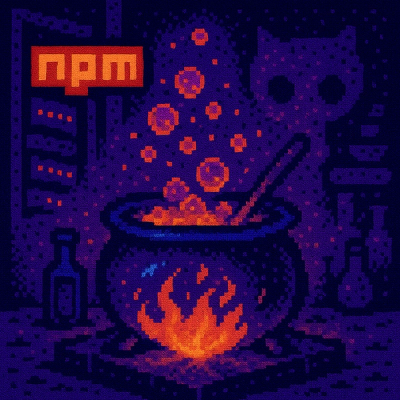
Security News
The Changelog Podcast: Practical Steps to Stay Safe on npm
Learn the essential steps every developer should take to stay secure on npm and reduce exposure to supply chain attacks.
ansys-optislang-core
Advanced tools
|pyansys| |python| |pypi| |PyPIact| |GH-CI| |codecov| |MIT| |black|
.. |pyansys| image:: https://img.shields.io/badge/Py-Ansys-ffc107.svg?logo=data:image/png;base64,iVBORw0KGgoAAAANSUhEUgAAABAAAAAQCAIAAACQkWg2AAABDklEQVQ4jWNgoDfg5mD8vE7q/3bpVyskbW0sMRUwofHD7Dh5OBkZGBgW7/3W2tZpa2tLQEOyOzeEsfumlK2tbVpaGj4N6jIs1lpsDAwMJ278sveMY2BgCA0NFRISwqkhyQ1q/Nyd3zg4OBgYGNjZ2ePi4rB5loGBhZnhxTLJ/9ulv26Q4uVk1NXV/f///////69du4Zdg78lx//t0v+3S88rFISInD59GqIH2esIJ8G9O2/XVwhjzpw5EAam1xkkBJn/bJX+v1365hxxuCAfH9+3b9/+////48cPuNehNsS7cDEzMTAwMMzb+Q2u4dOnT2vWrMHu9ZtzxP9vl/69RVpCkBlZ3N7enoDXBwEAAA+YYitOilMVAAAAAElFTkSuQmCC :target: https://docs.pyansys.com/ :alt: PyAnsys
.. |python| image:: https://img.shields.io/pypi/pyversions/ansys-optislang-core?logo=pypi :target: https://pypi.org/project/ansys-optislang-core/ :alt: Python
.. |pypi| image:: https://img.shields.io/pypi/v/ansys-optislang-core.svg?logo=python&logoColor=white :target: https://pypi.org/project/ansys-optislang-core/
.. |PyPIact| image:: https://img.shields.io/pypi/dm/ansys-optislang-core.svg?label=PyPI%20downloads :target: https://pypi.org/project/ansys-optislang-core/
.. |codecov| image:: https://codecov.io/gh/ansys/pyoptislang/branch/main/graph/badge.svg :target: https://codecov.io/gh/ansys/pyoptislang :alt: Codecov
.. |GH-CI| image:: https://github.com/ansys/pyoptislang/actions/workflows/ci_cd.yml/badge.svg :target: https://github.com/ansys/pyoptislang/actions/workflows/ci_cd.yml :alt: GH-CI
.. |MIT| image:: https://img.shields.io/badge/License-MIT-yellow.svg :target: https://opensource.org/licenses/MIT :alt: MIT
.. |black| image:: https://img.shields.io/badge/code%20style-black-000000.svg?style=flat :target: https://github.com/psf/black :alt: Black
PyOptiSLang is a Python wrapper for Ansys optiSLang. It supports Pythonic
access to Ansys optiSLang to be able to communicate with Ansys optiSLang directly from Python.
The latest ansys-optislang package provides these capabilities:
For comprehensive information on PyOptiSLang, see the latest release
documentation <https://optislang.docs.pyansys.com>. On the
PyOptiSLang Issues <https://github.com/ansys/pyoptislang/issues> page,
you can create issues to submit questions, report bugs, and request new features.
This is the best place to post questions and code.
The ansys-optislang-core package supports Python 3.9 through 3.13 on
Windows and Linux. Three modes of installation are available:
For either a developer or offline installation, consider using a virtual environment <https://docs.python.org/3/library/venv.html>_.
User installation
Install the latest release from `PyPi
<https://pypi.org/project/ansys-optislang-core/>`_ with this command:
.. code::
pip install ansys-optislang-core
Alternatively, install the latest `PyOptiSLang GitHub
<https://github.com/ansys/pyoptislang/issues>`_ package with this command:
.. code::
pip install git+https://github.com/ansys/pyoptislang.git
Developer installation
If you plan on doing local development with GitHub, clone and install PyOptiSLang with this code:
.. code::
git clone https://github.com/ansys/pyoptislang.git cd pyoptislang pip install -e .
A developer installation allows you to edit ansys-optislang-core
files locally. Any changes that you make are reflected in your setup
after restarting the Python kernel.
Offline installation
Using a wheelhouse can be helpful if you work for a company that restricts access to
external networks. From the `Releases <https://github.com/ansys/pyoptislang/releases>`_
page in the PyOptiSLang repository, you can find the wheelhouses for a particular release in its
assets and download the wheelhouse corresponding to your setup.
You can then install PyOptiSLang and all of its dependencies from one single entry point
that can be shared internally, which eases the security review of the PyOptiSLang package content.
For example, on Linux with Python 3.9, unzip the wheelhouse and install PyOptiSLang with code
like this:
.. code:: bash
unzip PyOptiSLang-v0.1.0-wheelhouse-Linux-3.9.zip wheelhouse
pip install ansys-optislang-core -f wheelhouse --no-index --upgrade --ignore-installed
If you're on Windows with Python 3.9, unzip the wheelhouse to a wheelhouse directory and
then install using the same ``pip`` command as in the preceding Linux code example.
Dependencies
--------------
You must have a local licensed copy or a remote instance of optiSLang installed. The first
supported version is 2023 R1.
Getting started
---------------
Using the ``Optislang`` class, you can either launch optiSLang locally or connect to a
remote optiSLang instance.
Launch optiSLang locally
For launching optiSLang locally, both the host and port parameters in the Optislang
class must be set to None, which are their defaults. Other parameters can optionally
be specified.
.. code:: python
from ansys.optislang.core import Optislang
osl = Optislang()
osl.dispose()
Connect to a remote optiSLang instance
For remote connection, it is assumed that an optiSLang instance is already running on
a remote (or local) host as a server. In this case, you must specify the ``host`` and ``port``
parameters. Parameters related to the execution of a new optiSLang instance are ignored.
.. code:: python
from ansys.optislang.core import Optislang
host = "127.0.0.1"
port = 5310
osl = Optislang(host=host, port=port)
osl.dispose()
Basic usage
~~~~~~~~~~~
This code shows how to launch optiSLang locally, open and run a Python
script file, save the results to a new project, and then close the
connection:
.. code:: python
from ansys.optislang.core import Optislang
osl = Optislang()
file_path = r"C:\Users\Username\my_scripts\myscript.py"
osl.application.project.run_python_file(path=file_path)
osl.application.save_copy("MyNewProject.opf")
osl.dispose()
License and acknowledgments
---------------------------
PyOptiSLang is licensed under the MIT license.
PyOptiSLang makes no commercial claim over Ansys whatsoever. This library extends the
functionality of Ansys optiSLang by adding a Python interface to optiSLang without
changing the core behavior or license of the original software. The use of the interactive control
of PyOptiSLang requires a legally licensed local copy of optiSLang.
For more information on optiSLang, see the `Ansys optiSLang <https://www.ansys.com/products/connect/ansys-optislang>`_
page on the Ansys website.
FAQs
A Python wrapper for Ansys optiSLang application.
We found that ansys-optislang-core demonstrated a healthy version release cadence and project activity because the last version was released less than a year ago. It has 1 open source maintainer collaborating on the project.
Did you know?

Socket for GitHub automatically highlights issues in each pull request and monitors the health of all your open source dependencies. Discover the contents of your packages and block harmful activity before you install or update your dependencies.

Security News
Learn the essential steps every developer should take to stay secure on npm and reduce exposure to supply chain attacks.

Security News
Experts push back on new claims about AI-driven ransomware, warning that hype and sponsored research are distorting how the threat is understood.

Security News
Ruby's creator Matz assumes control of RubyGems and Bundler repositories while former maintainers agree to step back and transfer all rights to end the dispute.